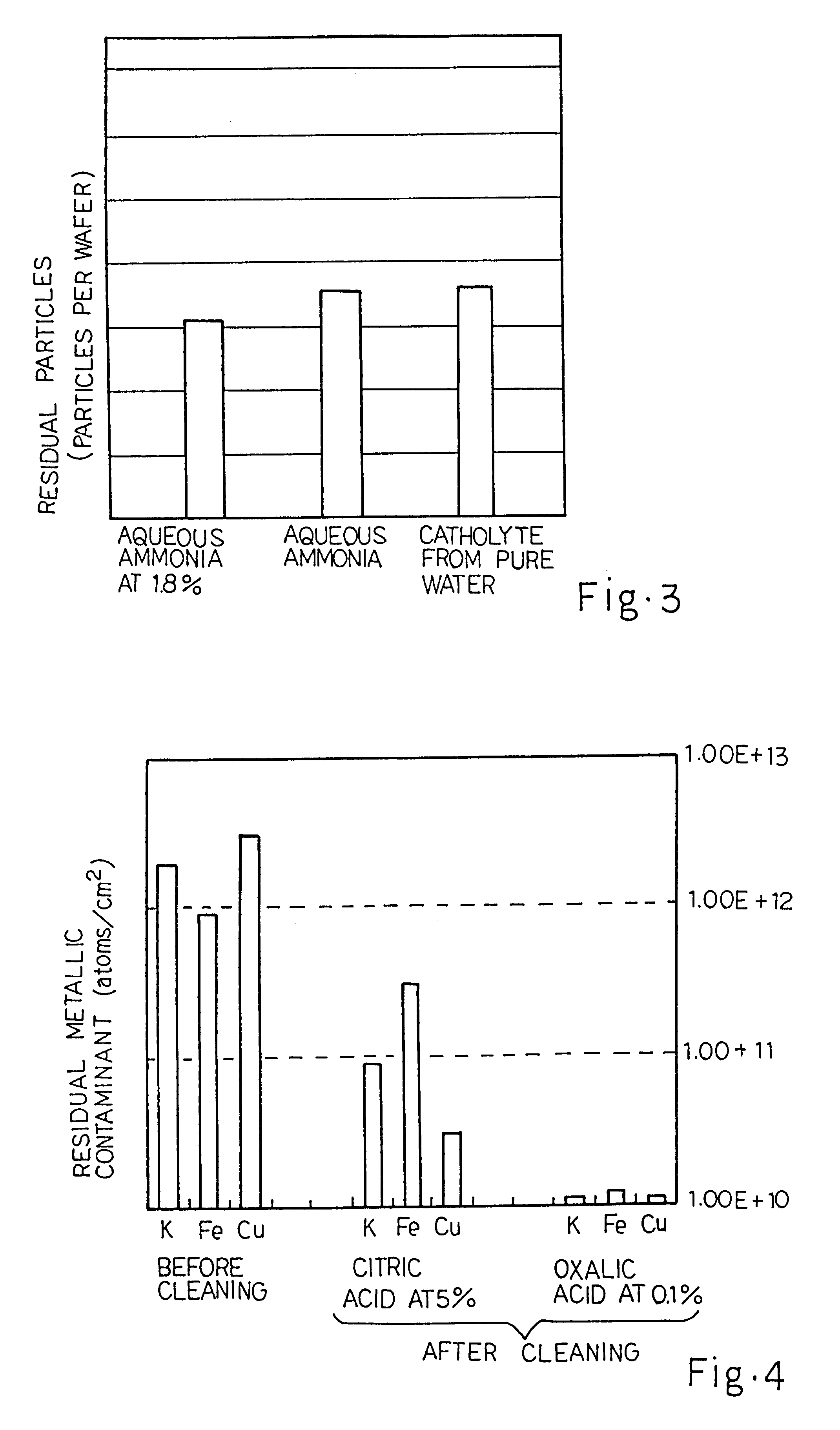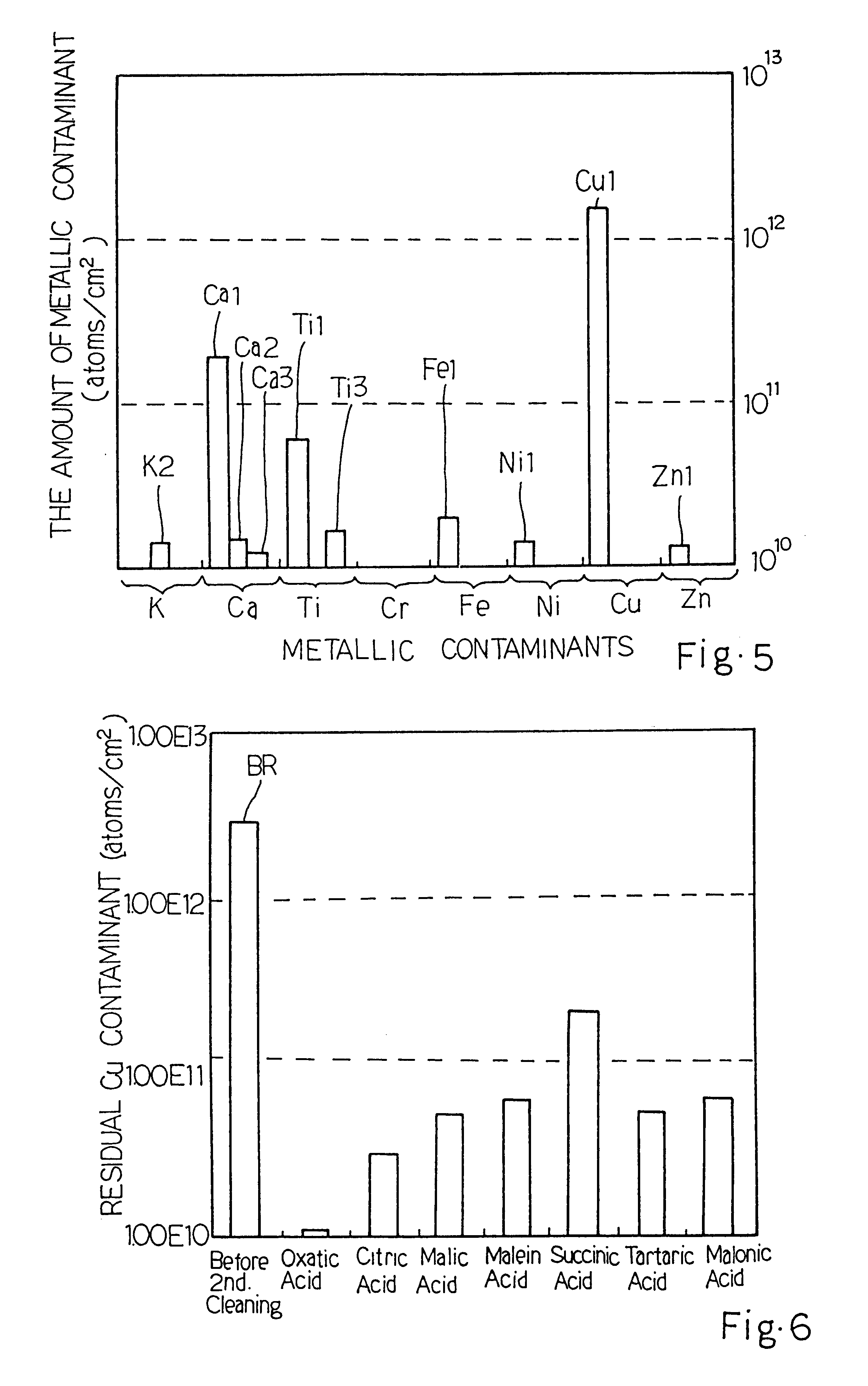Method for cleaning semiconductor wafer after chemical mechanical polishing on copper wiring
a technology for cleaning semiconductor wafers and copper wiring, which is applied in the direction of cleaning using liquids, semiconductor/solid-state device details, and lapping machines, etc., can solve the problems of contaminant deterioration of circuit components, present inventors cannot find any surface cleaning, and diluted hydrofluoric acid is not suitable for surface cleaning
- Summary
- Abstract
- Description
- Claims
- Application Information
AI Technical Summary
Benefits of technology
Problems solved by technology
Method used
Image
Examples
first example
A silicon wafer was chemically mechanically polished, and the semiconductor structure shown in FIG. 1 was completed on the silicon wafer. Polishing slurry had been supplied to the surface to be polished during the chemical mechanical polishing, and contained alumina particles. Upon completion of the chemical mechanical polishing, the silicon wafer was transferred to the loader of the cleaning system for the underwater storage. The silicon wafer was moved to the first chamber of the cleaning system.
Using the rolling brushes 32, the alumina particles were brushed away from both surfaces of the silicon wafer, and the aqueous ammonia at 0.001 weight percent was supplied to both surfaces of the silicon wafer during the brushing. The brushing was continued for 20-60 seconds. After the brushing, the silicon wafer was rinsed in pure water for 5-20 seconds, and residual ammonia was removed from the surfaces of the silicon wafer.
Subsequently, the silicon wafer was moved to the second chamber,...
second example
A silicon wafer was chemically mechanically polished under the conditions same as the first example, and the semiconductor structure shown in FIG. 1 was completed on the silicon wafer. The silicon wafer was stored in the loader of the cleaning system, and was transferred to the first chamber.
Using the brushes 32, the alumina particles were brushed away from both surfaces of the silicon wafer, and catholyte was sprayed onto both surfaces during the brushing. The catholyte was obtained through the electrolysis of pure water, pH and the oxidation-reduction potential were 7.0 and -650 millivolts with the reference electrode of AgCl. Upon completion of the first cleaning, the silicon wafer was rinsed as similar to the first example.
The silicon wafer was transferred to the second chamber, and was subjected to the second cleaning under the conditions same as the first example. After the second cleaning, the silicon wafer was rinsed, and dried as similar to the silicon wafer in the first ex...
third example
A silicon wafer was chemically mechanically polished under the conditions same as the first example, and the semiconductor structure shown in figure 1 was completed on the silicon wafer. The silicon wafer was stored in the loader of the cleaning system, and was transferred to the first chamber.
Using the brushes 32, the alumina particles were brushed away from both surfaces of the silicon wafer under the conditions same as those in the first example. The silicon wafer was rinsed in the pure water, and was transferred to the second chamber.
The silicon wafer was subjected to the second cleaning under the same conditions except the washer sprayed on the major surface of the silicon wafer. The washer contained oxalic acid at 0.1 weight percent. After the second cleaning, the silicon wafer was rinsed and dried as similar to the silicon wafer in the first example.
The present inventors confirmed that the alumina particles, the copper strip 5 and the metallic contaminants were removed from t...
PUM
| Property | Measurement | Unit |
|---|---|---|
| Fraction | aaaaa | aaaaa |
| Percent by mass | aaaaa | aaaaa |
| Percent by mass | aaaaa | aaaaa |
Abstract
Description
Claims
Application Information
 Login to View More
Login to View More - R&D
- Intellectual Property
- Life Sciences
- Materials
- Tech Scout
- Unparalleled Data Quality
- Higher Quality Content
- 60% Fewer Hallucinations
Browse by: Latest US Patents, China's latest patents, Technical Efficacy Thesaurus, Application Domain, Technology Topic, Popular Technical Reports.
© 2025 PatSnap. All rights reserved.Legal|Privacy policy|Modern Slavery Act Transparency Statement|Sitemap|About US| Contact US: help@patsnap.com



